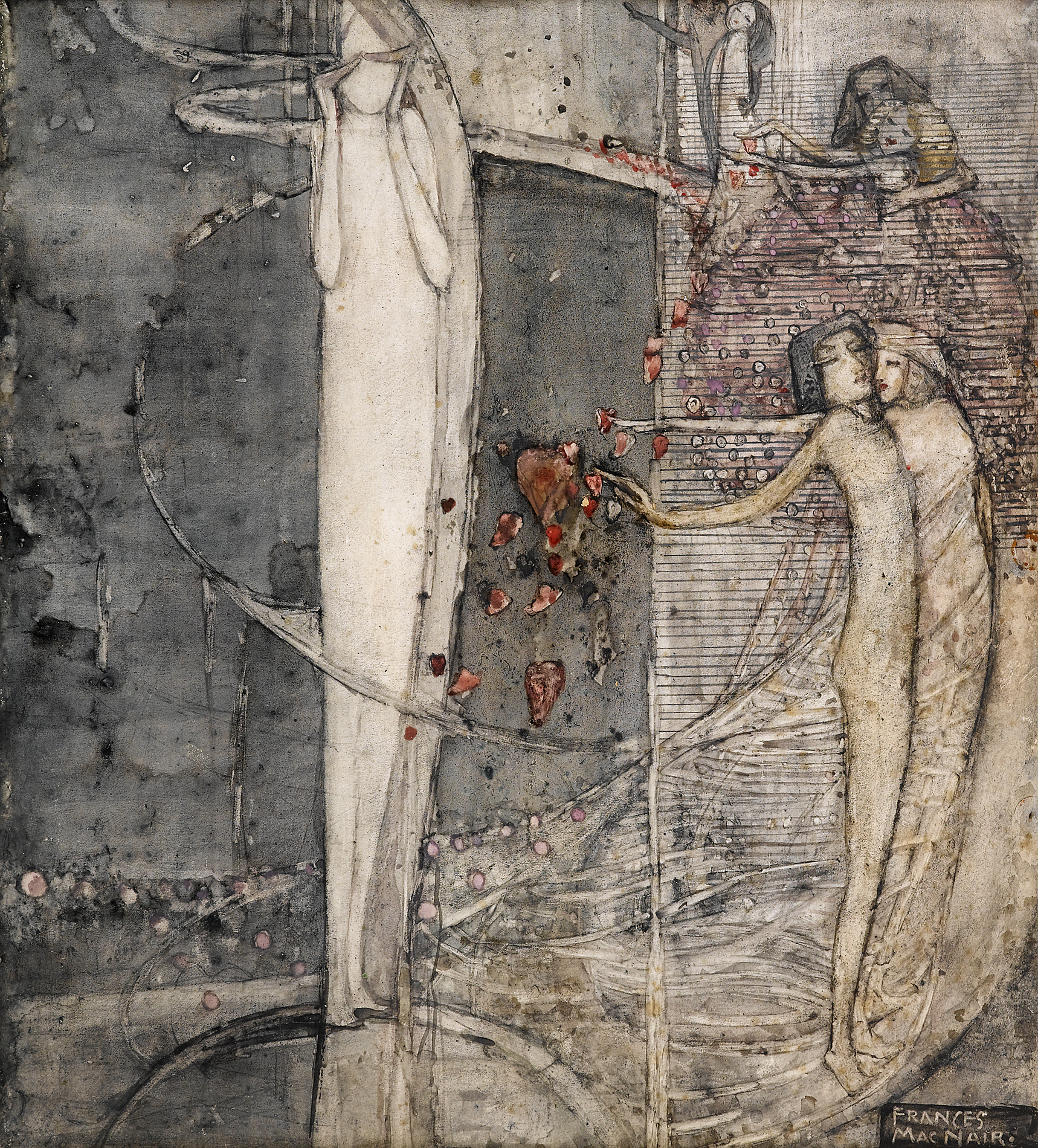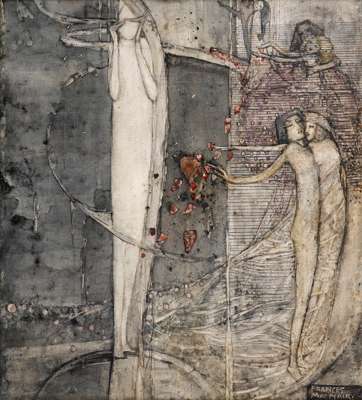
Lot 111

FRANCES MACDONALD MACNAIR (SCOTTISH 1874-1921) ‡
‘SLEEP’


Auction: 7 September 2012 at 15:00 BST
Description
signed bottom right FRANCES MACNAIR, watercolour and pencil on vellum
Dimensions
33 x 29cm (13 x 11in)
Footnote
Provenance:
Charles Macdonald Esq., the artist's brother
By descent to his daughter, Mrs. L. A. Dunderdale
Mario Amaya, acquired circa 1960-65
Christies, Edinburgh, 'Fine Paintings and Drawings', 13th May 1993, Lot 829
Exhibited:
possibly, Liverpool, Sandon Studios Society, 1908, no. 38
possibly, London, Allied Artists Association, 1908, no. 2099
possibly, London, The Baillie Gallery 'Watercolour Painting by Herbert and Frances MacNair', 1911, no. 20 (15 guineas)
Toronto, Art Gallery of Ontario 'The Sacred and Profane in Symbolist Art', 1969, no. 230
Glasgow, Hunterian Art Gallery and Liverpool, Walker Art Gallery 'Doves and Dreams: The Art of Frances Macdonald and J. Herbert MacNair', 12th August 2006 - 22nd April 2007, exhib. ref. W47
Literature:
Burkhauser, Jude 'Glasgow Girls: Women in Art and Design 1880-1920', Edinburgh 1990, p. 125, ill. Fig. 157, wrongly identified and dated as 'Eve', 1896.
Neat, Timothy 'Part Seen, Part Imagined: Meaning and Symbolism in the Work of Charles Rennie Mackintosh and Margaret Macdonald' Edinburgh 1994, illus. p. 66
Robertson, Pamela (Edit.) 'Doves and Dreams: The Art of Frances Macdonald and J. Herbert MacNair', Hampshire 2006, p. 170, exhib. ref. W47, cat. ill. 88
After marrying Herbert MacNair in 1899 Frances joined him in Liverpool, where he was an instructor at the University School of Architecture and Applied Art, and together they furnished and decorated a rented house at 54 Oxford Street. In 1905 the University transferred its Applied Art Department, where MacNair worked, to the Municipal Art School; MacNair left the new school shortly afterwards and helped establish an independent school in the city, the Sandon Studios. MacNair never really made enough money to keep his family while he was at the Sandon but he was cushioned by funds from his family in Scotland. Around 1908, however, that source of income faltered (and eventually disappeared in 1909 with his family's bankruptcy) and Herbert and Frances, with their young son Sylvan, returned to Glasgow.
What followed was a very disruptive period for them all. Frances managed to find part-time teaching at the School of Art, encouraged and supported by Fra Newbery, but Herbert found it impossible to find work as a teacher and his income as an artist dwindled further. They held a joint show at the Baillie Gallery in London in 1911 but sales were few. Herbert reportedly took to drink and various temporary jobs, for which he was almost always unsuited, and by 1913 he was in Canada, alone, his passage reputedly financed by the Macdonald family in an attempt to rescue Frances from the growing misery of their life together. Frances moved between Glasgow and Liverpool, again alone, trying unsuccessfully to establish herself as a teacher of embroidery - having left the Glasgow School of Art where she was an assistant to Anne Macbeth, the head of embroidery, whose methods and attitude to 'artistic' embroidery were completely at odds with Frances's own. MacNair returned to Glasgow in 1914, by now an alcoholic, and found work at the Post Office; in the same year Frances's mother died and her sister, Margaret Macdonald Mackintosh, left Glasgow for the south of England.
Few paintings or pieces of metalwork survive from the period after she arrived in Glasgow in 1908 and before her death (a possible suicide) in 1921 - the only coherent group is of seven paintings, probably produced after 1911 as they do not seem to have been included in the Baillie Gallery Exhibition. ('Sleep' has been identified with a work in this exhibition, and also as 'Eve', but there is nothing about this lot that identifies it as being the painting shown in 1911. The titles of all seven paintings in this group have been passed down through family tradition - they may not be titles ascribed by the artist. The Macdonald family obviously had an association, with and possession of, these paintings before Frances's death as Herbert is believed to have destroyed all of Frances's and his own surviving work after her death.)
These seven watercolours, all roughly the same size and having a similar handling, are generally interpreted as reflecting the vicissitudes and troubles of the artist's life, particularly after her return to Glasgow, but they also form a commentary on aspects of the life of women in general. If the current titles do reflect the content of the paintings then they provide a Rosetta Stone to an otherwise ambiguous group of images open, like so many Spook School works before them, to a variety of explanations - 'The Choice', 'Truth lies at the bottom of the Well', 'Tis a Long Path which Wanders to Desire' and so on. In several of the works the women are seen presented with choices or dilemmas; the palette and tonality verge on the depressive; their compositions are schematic, or episodic, seeming to tell different phases of the same story. Ambiguity pervades Sleep. What are the three episodes on the right of the painting? Do they represent various stages of a woman's life? Is the figure on the left hiding her eyes or simply weeping? Does she represent the age-old confusion between Death and Sleep? Like the other six paintings in the series it almost certainly reflects the troubled mind and life of a woman who has juggled the elements of wife, mother, daughter, sister, artist, teacher and no longer wishes to continue the struggle. There is a raw northern symbolism about them, a Celtic version of the angst often identified in the contemporary paintings of Munch, and by far the most powerful of any contemporary work by The Four

